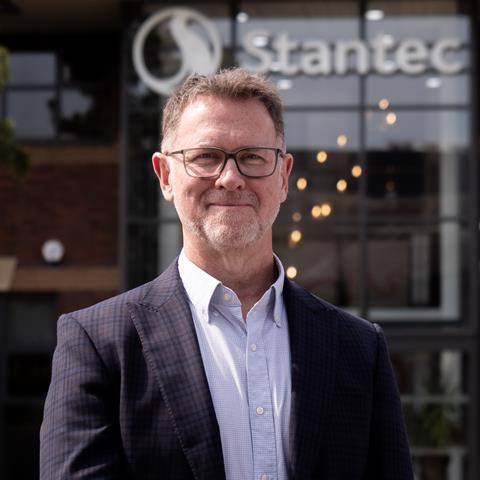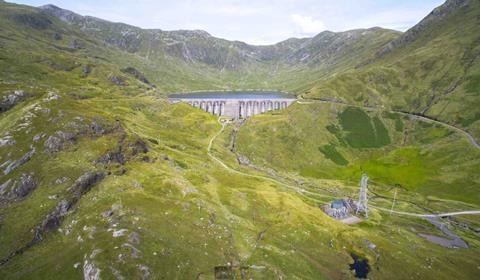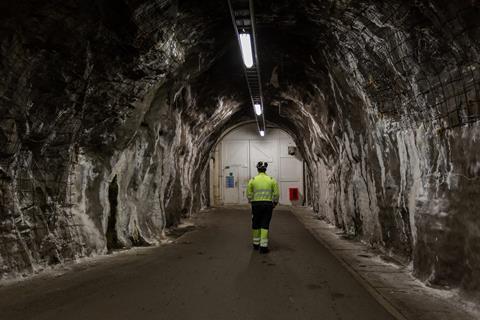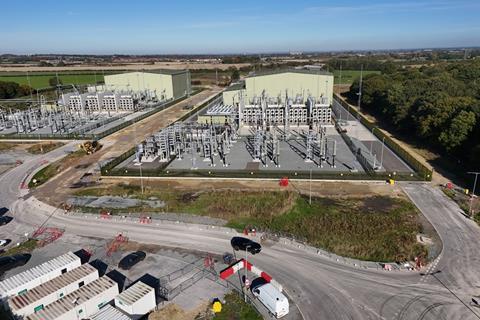As the government presses ahead with its plan to decarbonise the UK grid by 2030, the engineering firm aims to take advantage of the huge amount of infrastructure work up for grabs over the next 10 years. Managing director Brian Yates tells Tom Lowe there are exciting times ahead

Brian Yates is moving to London later this year, but it will not be his first time living in the capital. When StantecŌĆÖs new managing director for the UK and Ireland was 20, he spent a summer working in the city as a fishmonger at Selfridges.
The Canada native loved almost everything about London ŌĆō ŌĆ£had I not had a girlfriend waiting for me back in Nova Scotia, I would have stayedŌĆØ ŌĆō except for the jellied eels.ŌĆ£They wanted me to taste everything that we were selling,ŌĆØ he explains.
ŌĆ£The taste didnŌĆÖt really stick with me. But what I really didnŌĆÖt like was the consistency where, because itŌĆÖs an eel, youŌĆÖve got these ribs in each segment.ŌĆØ He shudders at the memory.
Yates is now returning to the city in rather more lofty circumstances. He has been tasked with overseeing a huge expansion of StantecŌĆÖs presence in the region, both through acquisitions and organic growth of its own workforce. LabourŌĆÖs moonshot pledge to decarbonise the UKŌĆÖs energy grid by 2030 has opened a window for the engineering firm, dangling the opportunity of a vast amount of work for engineers and infrastructure specialists in the energy sector.
Brian YatesŌĆÖ CV
- 1991: Jacques Whitford, environmental analyst, Dartmouth, Nova Scotia
- 1992 - 1994: ADI Group Inc, environmental analyst, Halifax, Nova Scotia
- 1994 - 1996: Dalhousie University, Environmental Management and Development in Indonesia Project, project officer, Jakarta, Indonesia
- 1996 - 2001: Jacques Whitford, division manager, Vancouver, British Columbia
- 2001 - 2003: EVS Environment, senior environmental consultant, Vancouver, British Columbia
- 2003 - 2004: Canadian Environmental Assessment Agency, program officer, Vancouver, British Columbia
- 2004 - 2005: The Blueprint Initiative Asia Pte Ltd, managing director, Singapore
- 2005 - 2007: Simon Fraser University, project manager, Burnaby, British Columbia
- 2006 - 2007: Genome British Columbia, business development manager
- 2007 - 2011: Hemmera, planning and management group business leader, Vancouver, British Columbia
- 2011 - 2018: SNC Lavalin, impact assessment and community engagement vice president, British Columbia and Yukon
- 2018 - 2024: Stantec, vice president, regional leader, British Columbia
- May 2024: Stantec, managing director, UK and Ireland
It will not just involve massively expanding capacity in renewable energy ŌĆō including offshore wind, which the government somewhat ambitiously wants to quadruple within the next six years ŌĆō but also a complete overhaul of the countryŌĆÖs electricity infrastructure. The National Grid has said it will need to build five times more electricity transmission upgrades over the next six years than it has done over the past three decades just to accommodate the governmentŌĆÖs offshore wind ambitions.
WeŌĆÖve talked about being able to double our business in the UK, whether itŌĆÖs two, five or 10 years. I think thatŌĆÖs entirely reasonable
It is this work which Yates sees as one of many exciting growth sectors for StantecŌĆÖs business in the region, which currently has a turnover of around ┬Ż245m. ŌĆ£We can easily be half again or even double that,ŌĆØ he claims.
ŌĆ£WeŌĆÖve talked about being able to double our business in the UK, whether itŌĆÖs two, five or 10 years. I think thatŌĆÖs entirely reasonable. I think I could easily see us, before I retire, being twice the size we are now.ŌĆØ
When does he plan to retire? ŌĆ£When we double in sizeŌĆØ.
The firm, which was founded in 1954 in Edmonton, Canada, reported a global turnover of ┬Ż3.93bn in its latest accounts and operates 450 offices globally. Its headcount stands at around 31,000 employees, with close to 4,000 working in the UK.
Around 1,000 of these were added in May this year when it acquired Bristol-based Hydrock, a ┬Ż74m-turnover regional rival. Previous acquisitions in the UK include Barton Willmore, Esi Consulting, Peter Brett Associates and MWH.
Yates says Stantec is ŌĆ£pretty bullishŌĆØ about the opportunity to expand further in the UK because of the policy consistency from Labour, which unveiled its 10-year industrial strategy this month. ŌĆ£They provide a lot of clarity about where they want to go, and weŌĆÖre looking forward to a continuation of that,ŌĆØ he says.
He has spent most of the past three decades in Vancouver, on the west coast of Canada, where he was until recently responsible for the engineering firmŌĆÖs business in British Columbia. But it is in the UK where he sees greater potential for growth.
ŌĆ£ThatŌĆÖs why I came here,ŌĆØ he says. ŌĆ£British Columbia is a great place to live, right? Vancouver is fantastic, but I was looking at what is coming in the United Kingdom and Ireland, and you know, from a public policy perspective, where you want to go for opportunities.
ŌĆ£I am very excited to be here, and I think thereŌĆÖs a lot of opportunity for us going forward.ŌĆØ

║├╔½Ž╚╔·TV is speaking to Yates in StantecŌĆÖs office in Farringdon, but he is currently based in Manchester. He moved there earlier this year and is spending a few months being brought up to speed on the UK market by his predecessor Cath Schefer. He says he is enjoying his time there, although his first impression of the city came as a surprise.
Yates had based his expectations on the opening titles of Coronation Street. This may seem unlikely, but he is a seasoned viewer of the soap opera, which he used to watch with his parents when growing up in Canada in the 1970s along with other UK imports including the QueenŌĆÖs annual Christmas messages.
ŌĆ£When I arrived in Manchester, I had those biases around what I would see on TV,ŌĆØ he admits. ŌĆ£And I was surprised at how modern and how vibrant Manchester is right now compared to the opening theme of Coronation Street.ŌĆØ
I envied all the cities that would get rock stars coming to perform. David Bowie would never go to Halifax
He compares the cityŌĆÖs transformation over the past few decades to his hometown, New Glasgow, an industrial city on the northern coast of Nova Scotia. Returning there a few years ago, he noted how much it had changed.
ŌĆ£I was thinking, I wish it had been like that when I was growing up. Even the river was unswimmable when I was a kid. And now people are regularly jumping in it.ŌĆØ
It was in Nova Scotia that he started his career as a biologist and environmental scientist, working for a local firm, Jacques Whitford. But he was restless ŌĆō ŌĆ£I envied all the cities that would get rock stars coming to perform. David Bowie would never go to HalifaxŌĆØ ŌĆō and so he ended up moving to Indonesia to help develop environmental projects in the country, working on a Canadian government-funded project for Nova ScotiaŌĆÖs Dalhousie University.
After three years he moved back to Canada, to Vancouver, with his girlfriend at the time, now his wife, partly because it was a big international city. Apart from an 18-month stint in Singapore, he spent most of the next two decades working for companies on the Canadian west coast including AtkinsRealis predecessor SNC Lavalin, where he led the community engagement business in British Columbia and Yukon.

In 2018 he was appointed vice-president of British Columbia at Stantec, which has nine offices in the region and more than 1,000 staff. The province produces almost all (98%) of its energy from renewable sources, and YatesŌĆÖ experience with the market has shaped his view of the potential for the firm in the UK.
One of his first projects, at the beginning of his career, was a thermal coal mine, but he has always been passionate about more sustainable forms of energy.
ŌĆ£In the early 90s, I used to wonder when IŌĆÖd be able to work on a wind farm. These things were pie in the sky. They werenŌĆÖt realŌĆ” and now, itŌĆÖs hereŌĆØ he says.
ŌĆ£IŌĆÖm living in a context where governments and the public and even our investors are all wanting us to pursue net zero goals, projects that deliver value to local communities and environmental benefits.ŌĆØ
Right now weŌĆÖve got the opportunity to help and shape the essential infrastructure for generations in the United Kingdom and Ireland
While he sees most of the developed world heading in the same direction on net zero, he believes the UK is further ahead along this course than even North America and more ŌĆ£explicitŌĆØ about the need to build vast amounts of new infrastructure in order to achieve these goals. ŌĆ£That really excites me,ŌĆØ he says.
ŌĆ£The thing that is attractive ŌĆō not just for me, but I think should be for anyone in our business ŌĆō is right now weŌĆÖve got the opportunity to help and shape the essential infrastructure for generations in the United Kingdom and Ireland.ŌĆØ
Part of the problem is the decentralisation of energy sources, which currently run mostly from fossil fuel plants in the North of the country to more populated areas in the South. The expansion of renewable sources, both through onshore wind scattered across the country and offshore wind off the east coast in sites like the massive Dogger Bank project, requires the grid to be reconfigured on an ŌĆ£unprecedentedŌĆØ scale, according to the boss of the National Grid. John Pettigrew told The Times this month that the task was the ŌĆ£equivalent of what the Victorians didŌĆ” in terms of the scale of infrastructureŌĆØ.

The upheaval that this work could cause to local communities, through digging up streets and building new pylon networks, is likely to see Labour come under attack from both the right and left of the political spectrum over the next few years. Former Conservative energy secretary Claire Coutinho branded the partyŌĆÖs plans as ŌĆ£mad, bad and dangerousŌĆØ during this yearŌĆÖs general election, while at the Labour conference in September, Gary Smith, the leader of the GMB union, said there had been a ŌĆ£fundamental dishonestyŌĆØ in the debate about the costs of decarbonisation in the UK.
Smith, who has become the arch nemesis of LabourŌĆÖs green lobby, claimed the idea that the transition from gas to electricity could be achievable without massive cost to the economy through harm to existing fossil fuel industries was ŌĆ£frankly just not real worldŌĆØ.
But the cost of not pushing forward is already evident. British SteelŌĆÖs ambitions to switch to producing ŌĆ£green steelŌĆØ were set back this month when the National Grid told the firm that it would not have access to a new electricity connection before 2032. The steelmaker had hoped to switch to a lower carbon electric arc furnace at its Scunthorpe plant next year.
It can currently take up to 15 years for wind and solar projects to secure a connection to the grid, according to research by energy consultancy Cornwall Insight, while more than 60% of projects waiting for a connection did not progress at all between 2018 and 2023. Meanwhile, a report by the House of Commons Environmental Audit Committee this year found that there was more than double the amount of renewable energy generation in the pipeline than was needed to achieve the previous governmentŌĆÖs 2035 net zero power target.
Yates has said he would like to see Stantec become a ŌĆ£trusted advisorŌĆØ to the government, and this is where his community engagement experience in British Columbia may come in useful. He stresses the opportunities for the UK.
ŌĆ£Global investment wants to find projects that are powered by clean power, and in a context where thereŌĆÖs a lot of sustainability goals. IŌĆÖve seen that elsewhere. In the jurisdiction I came from, it was the same,ŌĆØ he says.
ŌĆ£ItŌĆÖs an exciting time to be in our business, and I think the more we communicate that to our clients and potential recruits and so on, itŌĆÖs good for us. But itŌĆÖs also just a reason for optimism, because I think, directionally, the UK and Ireland is going the right way.ŌĆØ


























No comments yet